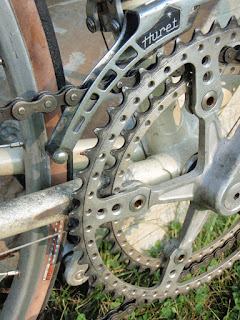Frame and Wheel agrees that the bike business has an element of fashion to it. Consumers watch what the pros ride and they say to themselves: I want to ride that bike. Same is true with fashion: consumers see what a celebrity wears to the Oscars and they say: I want to wear the same thing. Both bicycle and fashion consumers are happy to settle for slightly different versions once they find out the cost of the versions they see in the magazines and on television.
The frames Frame and Wheel will obtain from Asia can be delivered with all the latest details that are currently in fashion: internal cabling for the brakes and the derailleuers; integrated seat posts; BB30, etc. These are additions that the industry has added to the basic bike frame and convinced the market as being the next necessary thing. Frame and Wheel wants to keep it simple: the demo frames that have been ordered are pretty basic when it comes to features: BSA bottom bracket, external cabling, traditional seat post (Frame and Wheel did go for braze on front derailleur rather than the traditional version and internal rear cabling, because these innovations are pretty simple). Frame and Wheel even kept the paint job to a single color: white. The reasoning is this: internal cabling can be a real pain for the mechanic, especially if the system is new and not proven; integrated seat posts save some weight and look cool, but they make it very difficult to travel with the frame (not to mention higher shipping costs), and it requires taking a hacksaw to the frame. Once it is cut, its resale potential is limited because the frame can only fit a person who is the same height as the original owner.
Frame and Wheel's intention of keeping things simple complements the Austro-Daimler brand: in the early 80s, there was not a planned obsolescense strategy by bike companies; a series of models were introduced and that was it; the frames were not repainted and tweaked each year, and then thrust upon the dealer. The significance is that the bike industry resembles in many ways the fashion industry. Indeed, Fashion Week in New York conicides with Euro Bike in Europe and the big trade show in Nevada next week. Frame and Wheel believes that it is useful to look at the fashion industry to get a better understanding about the bike industry and the consumer.
Frame and Wheel found two interesting article in the Wall Street Journal that describe what designers think about their markets.
Luxury-Goods Firms Turn Up Volume on Value refers to a Bain & Co. study that concludes that the luxury consumers "want styles with longevity" and the "new watchword in luxury is value, in the form of quality and staying power." One retail executive is optimistic about the core luxury shopper, but identifies the "middle territory" as the biggest problem. The middle territory are consumers who are aspirational shoppers, consumers who stretched their budgets to obtain the latest, trendy thing (a $1,500 handbag without a point of view). Elsewhere, one designers says she is ready for "real clothes, things that I wnat to buy and keep for years" or real clothing and value. Respondents to the the Bain & Co. study say that two thirds of their purchases this year have been weighted towards "classic" styles; and about 80% of shoppers say that they are willing to pay for apparel that lasts more than one season.
Designers Reclaim Individual Voices notes that designers are going "classic and risk-free"
Frame and Wheel reads about these sentiments when perusing the website of titanium and steel frame manufacturers. Indeed, Rob Penn, the author of It's All about the Bike, says very clearly that he wants a bike that he can grow old with, and that would last forever; he dismisses carbon frames and reveals himself as a purisit. Regardless, Mr. Penn purchases a custom steel O'Rourke frame and he is happy with it.
Frame and Wheel agrees that there is great joy in having a bicycle that will last longer than a season, and that will not be obsolete within two seasons. Frame and Wheel tried Mr. Penn's approach years ago and ended up with a very heavy Moots mountain bike (which is in the attic). The reality is that the bicycle industry has adopted the car industry's planned obsolescence strategy. This is a classic "push strategy" that results in huge investments in manufacturing, distribution and sales infrastructure (in the pursuit of ecnomies of scale); the bikes are built and pushed into the market. Although planned obsolescence results in new innovations coming to the market, it also means that the forever bike is going to become obsolete pretty quickly given that the technology is changing so rapidly. The bigger problem is that planned obsolescence creates a lot of waste and exasperation with waste and rapidly changing fashions is clearly identifiable in the fashion industry.
Frame and Wheel suspects that consumers of bicycles feel the same way and thus remains committed to developing a sustainability strategy that address the frailties of carbon. The timing then is perhaps right for a classic brand that offers quality and longevity to the consumer through the use of a
pull model and the principles of frugal innovation as well as a sustainability strategy. Frame and Wheel notes that with control of a classic brand in hand, the company could very well retain a local steel frame builder to develop reissue frames. A topic for another post.




